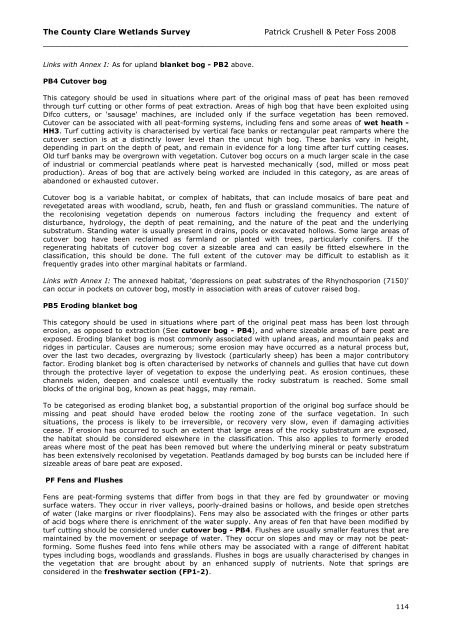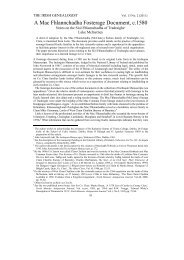Report Cover Vol I - Clare County Library
Report Cover Vol I - Clare County Library
Report Cover Vol I - Clare County Library
You also want an ePaper? Increase the reach of your titles
YUMPU automatically turns print PDFs into web optimized ePapers that Google loves.
The <strong>County</strong> <strong>Clare</strong> Wetlands Survey Patrick Crushell & Peter Foss 2008<br />
_______________________________________________________________<br />
Links with Annex I: As for upland blanket bog - PB2 above.<br />
PB4 Cutover bog<br />
This category should be used in situations where part of the original mass of peat has been removed<br />
through turf cutting or other forms of peat extraction. Areas of high bog that have been exploited using<br />
Difco cutters, or 'sausage' machines, are included only if the surface vegetation has been removed.<br />
Cutover can be associated with all peat-forming systems, including fens and some areas of wet heath -<br />
HH3. Turf cutting activity is characterised by vertical face banks or rectangular peat ramparts where the<br />
cutover section is at a distinctly lower level than the uncut high bog. These banks vary in height,<br />
depending in part on the depth of peat, and remain in evidence for a long time after turf cutting ceases.<br />
Old turf banks may be overgrown with vegetation. Cutover bog occurs on a much larger scale in the case<br />
of industrial or commercial peatlands where peat is harvested mechanically (sod, milled or moss peat<br />
production). Areas of bog that are actively being worked are included in this category, as are areas of<br />
abandoned or exhausted cutover.<br />
Cutover bog is a variable habitat, or complex of habitats, that can include mosaics of bare peat and<br />
revegetated areas with woodland, scrub, heath, fen and flush or grassland communities. The nature of<br />
the recolonising vegetation depends on numerous factors including the frequency and extent of<br />
disturbance, hydrology, the depth of peat remaining, and the nature of the peat and the underlying<br />
substratum. Standing water is usually present in drains, pools or excavated hollows. Some large areas of<br />
cutover bog have been reclaimed as farmland or planted with trees, particularly conifers. If the<br />
regenerating habitats of cutover bog cover a sizeable area and can easily be fitted elsewhere in the<br />
classification, this should be done. The full extent of the cutover may be difficult to establish as it<br />
frequently grades into other marginal habitats or farmland.<br />
Links with Annex I: The annexed habitat, 'depressions on peat substrates of the Rhynchosporion (7150)'<br />
can occur in pockets on cutover bog, mostly in association with areas of cutover raised bog.<br />
PB5 Eroding blanket bog<br />
This category should be used in situations where part of the original peat mass has been lost through<br />
erosion, as opposed to extraction (See cutover bog - PB4), and where sizeable areas of bare peat are<br />
exposed. Eroding blanket bog is most commonly associated with upland areas, and mountain peaks and<br />
ridges in particular. Causes are numerous; some erosion may have occurred as a natural process but,<br />
over the last two decades, overgrazing by livestock (particularly sheep) has been a major contributory<br />
factor. Eroding blanket bog is often characterised by networks of channels and gullies that have cut down<br />
through the protective layer of vegetation to expose the underlying peat. As erosion continues, these<br />
channels widen, deepen and coalesce until eventually the rocky substratum is reached. Some small<br />
blocks of the original bog, known as peat haggs, may remain.<br />
To be categorised as eroding blanket bog, a substantial proportion of the original bog surface should be<br />
missing and peat should have eroded below the rooting zone of the surface vegetation. In such<br />
situations, the process is likely to be irreversible, or recovery very slow, even if damaging activities<br />
cease. If erosion has occurred to such an extent that large areas of the rocky substratum are exposed,<br />
the habitat should be considered elsewhere in the classification. This also applies to formerly eroded<br />
areas where most of the peat has been removed but where the underlying mineral or peaty substratum<br />
has been extensively recolonised by vegetation. Peatlands damaged by bog bursts can be included here if<br />
sizeable areas of bare peat are exposed.<br />
PF Fens and Flushes<br />
Fens are peat-forming systems that differ from bogs in that they are fed by groundwater or moving<br />
surface waters. They occur in river valleys, poorly-drained basins or hollows, and beside open stretches<br />
of water (lake margins or river floodplains). Fens may also be associated with the fringes or other parts<br />
of acid bogs where there is enrichment of the water supply. Any areas of fen that have been modified by<br />
turf cutting should be considered under cutover bog - PB4. Flushes are usually smaller features that are<br />
maintained by the movement or seepage of water. They occur on slopes and may or may not be peatforming.<br />
Some flushes feed into fens while others may be associated with a range of different habitat<br />
types including bogs, woodlands and grasslands. Flushes in bogs are usually characterised by changes in<br />
the vegetation that are brought about by an enhanced supply of nutrients. Note that springs are<br />
considered in the freshwater section (FP1-2).<br />
114
















